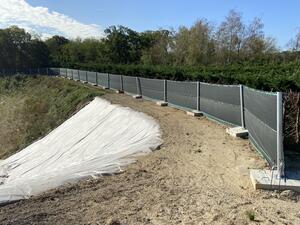Our tips for choosing a privacy screen
A picture depicting a privacy screen around a waste treatment facility. Introduction: Privacy Screens for Waste Facilities Waste treatment facilities and processing sites often cover large outdoor areas. To avoid disturbing the surroundings with a view of waste, many companies implement privacy screens as concealment equipment around their premises. Each type of privacy screen has its own characteristics concerning the level of concealment and the materials used. OTEXIO provides expert advice on how to choose the right privacy screen to suit your situation.

Light Concealment Privacy Screens allow light to pass through and provide slight visibility through their mesh. This includes natural cane screens and certain artificial hedges.
Medium Concealment Privacy Screens offer privacy while allowing some light to pass through, such as cane screens, artificial hedges, and highly porous fabrics.
Full Concealment Privacy Screens provide complete visual protection and block even light from passing through. This is often the case with dense natural hedges and tightly woven fabrics.
Roll-shaped privacy screens can typically be stapled to a support such as a fence. Staples should be placed at regular intervals, around every 25 cm. If you prefer temporary fastening, there are also clips that can be attached at the top and bottom of the privacy screen.
PVC fabrics and nets often have eyelets through which tension wires must be threaded to secure them. To ensure a secure fit for your fabric, make sure to properly tension the wires. You now have all the information you need to install your privacy screen.
However, before proceeding with the installation, take the time to familiarize yourself with any applicable regulations, whether regarding allowed height or color choices.


What are the different types of privacy screen?
Different Types of Privacy Screens Privacy screens come in a wide variety of different models. Whether they are hedges, natural elements, or synthetic materials, they all serve the same purpose: preventing your facility from being visible from the outside. Here are the different types of privacy screens available for concealing your outdoor space.Natural privacy screens
This type of privacy screen is composed of natural materials such as wood or plant fibers. Common models include wicker cane, bamboo, or heather thatched screens. They consist of compact natural materials arranged together to form a natural concealment barrier. Wooden panels also fall under this category. Appreciated for their natural visual appearance that blends into the surroundings, these privacy screens have the advantage of offering a good quality-to-price ratio. However, their lifespan can be shortened by adverse outdoor conditions such as frequent rain, snow, or strong sunlight...Synthetic privacy screens
Synthetic privacy screens are made from plastic materials like PVC or polyethylene. In this category, you can find examples like PVC cane screens or plastic privacy slats that attach to fences. These concealment solutions are generally of good quality and valued for their ease of installation. They come in numerous models, offering a wide range of colors and appearances. However, plastic slats tend to deteriorate under the effects of sunlight and weather conditions.Natural hedges
Hedges provide a highly appreciated natural aspect that harmoniously blends into the surroundings. Certain plant species like thuja are often chosen for their rapid growth and strong concealing ability. However, achieving a satisfactory height and density requires waiting for several years. Young hedges can take a long time to grow. It's also important to note that natural hedges require regular pruning to maintain a pleasing shape and sufficient density.Synthetic hedges
The primary advantage of artificial hedges is that they mimic the aesthetic appearance of natural hedges without requiring maintenance. With simple installation and a wide range of colors and appearances, synthetic hedges offer a good quality-to-price ratio.Woven fabric privacy screens
This type of privacy screen offers a clean and polished visual effect. Numerous models are available on the market, offering a wide variety of colors and patterns. These products are designed for outdoor installation, with appropriate UV treatments. UV-treated fabrics retain their colors for years and are also easy to install.Privacy screen nets
Privacy screen nets are an ideal solution for concealing the outdoor areas of businesses. This type of product comes in various models, differing in appearance and concealment level. These nets can also serve as windbreaks and dust protection, which is especially useful for waste treatment sites.Choosing a privacy screen based on concealment level
Brise-vue (privacy screens) can be categorized into three levels of concealment.Light Concealment Privacy Screens allow light to pass through and provide slight visibility through their mesh. This includes natural cane screens and certain artificial hedges.
Medium Concealment Privacy Screens offer privacy while allowing some light to pass through, such as cane screens, artificial hedges, and highly porous fabrics.
Full Concealment Privacy Screens provide complete visual protection and block even light from passing through. This is often the case with dense natural hedges and tightly woven fabrics.
Choosing a privacy screen based on installation method
There are various installation methods and fastening systems for privacy screens.Roll-shaped privacy screens can typically be stapled to a support such as a fence. Staples should be placed at regular intervals, around every 25 cm. If you prefer temporary fastening, there are also clips that can be attached at the top and bottom of the privacy screen.
PVC fabrics and nets often have eyelets through which tension wires must be threaded to secure them. To ensure a secure fit for your fabric, make sure to properly tension the wires. You now have all the information you need to install your privacy screen.
However, before proceeding with the installation, take the time to familiarize yourself with any applicable regulations, whether regarding allowed height or color choices.